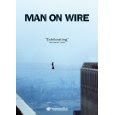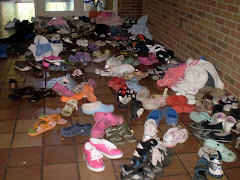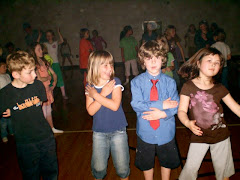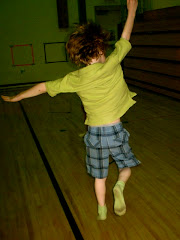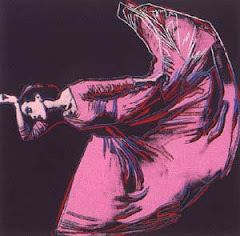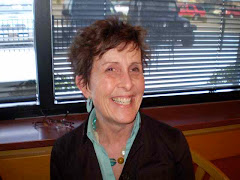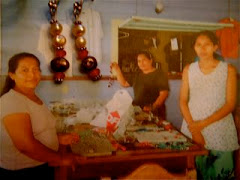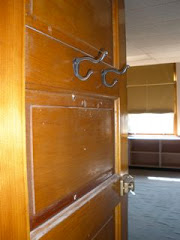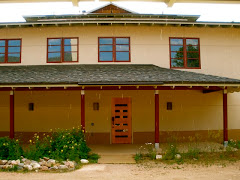 Wabi Sabi: Wabi ... connotes rustic simplicity, freshness or quietness, and can be applied to both natural and human-made objects, or understated elegance. It can also refer to quirks and anomalies arising from the process of construction, which add uniqueness and elegance to the object.Sabi is beauty or serenity that comes with age, when the life of the object and its impermanence are evidenced in its patina and wear, or in any visible repairs.".....Wabi Sabi, from Wikipedia
Wabi Sabi: Wabi ... connotes rustic simplicity, freshness or quietness, and can be applied to both natural and human-made objects, or understated elegance. It can also refer to quirks and anomalies arising from the process of construction, which add uniqueness and elegance to the object.Sabi is beauty or serenity that comes with age, when the life of the object and its impermanence are evidenced in its patina and wear, or in any visible repairs.".....Wabi Sabi, from WikipediaTuesday, September 21, 2010
Old Things
 Wabi Sabi: Wabi ... connotes rustic simplicity, freshness or quietness, and can be applied to both natural and human-made objects, or understated elegance. It can also refer to quirks and anomalies arising from the process of construction, which add uniqueness and elegance to the object.Sabi is beauty or serenity that comes with age, when the life of the object and its impermanence are evidenced in its patina and wear, or in any visible repairs.".....Wabi Sabi, from Wikipedia
Wabi Sabi: Wabi ... connotes rustic simplicity, freshness or quietness, and can be applied to both natural and human-made objects, or understated elegance. It can also refer to quirks and anomalies arising from the process of construction, which add uniqueness and elegance to the object.Sabi is beauty or serenity that comes with age, when the life of the object and its impermanence are evidenced in its patina and wear, or in any visible repairs.".....Wabi Sabi, from WikipediaI came across this concept in an article last night in one of those magazines whose mission it is to provide us with ways to cope with our lives and achieve some balance and peace. The author encourages the reader to abandon all attempts at perfection and embrace life's anomolies and flaws as the real essence of beauty; to cherish the inevitable evidence of wear, time and human limitations that we seem to wage war against every day. I thought of my aging face and body; I was just standing in front of an aisle full of "anti-aging" potions at the drugstore, reading labels and wondering, hoping against hope that some of them really would turn back the hands of time. Succumbing to these moments of vanity and insecurity is something we all do, and of course these products cash in on that. Our Western preoccupation with perfection keeps us anxiously wondering if we, and all that we have, are good enough.
My face is getting more unique as time goes by. My artificial eye is sinking in a little, not so that the casual observer would notice, but I can tell. Because it doesn't close all the way, I sleep with it pushed into my pillow, and the left side of my face bears the lines and wrinkles that have been pressed into it permanently. When I wear makeup, the watery discharge that comes from my fake eye smears it. My eyelashes stick out at a different angle because of the change in the shape of my eyeball. Add to this the consequences of a lifetime in the sun, smoking and general self-abuse, and you have the face of a somewhat leathery woman who looks older than her years. At least, this is what I see. Most days, I try to spend as little time as I can in front of the mirror, but when I am confronted with the idea of aging and beauty and my drift away from any hope of regaining my youthful symmetry and normalcy, it can be depressing. As I write this, I feel a little revulsion at my vanity and shallowness, but this is the truth of it. Not all of the time, you understand. But sometimes.
Back to wabi sabi-those of us who like to go to antique malls and find treasures with the ghosts of their former owners inherent in them know all about that...we run our hands over the soft patina of the back of the wooden chair, the color made lighter by so many hands doing the same thing. I toured an old country estate last weekend, and the staircase railing, made of brass, was shiny -bright at the base, where your hand would rest at the beginning of your climb. Likewise the knees of the huge Buddhas at the Art Institute. My old restaurant ware, discovered a piece or two at a time like rare wildflowers, has worn glaze from silverware and little imperfections in the green trim. My old Japanese chest, brought back from my ex-husband's brother during the Korean war, has many chips and dings along its edges from half a century of use. My favorite shoes are bent and molded uniquely, as only my feet could do, reflecting thousands of steps, some of them taken with people I love, others doing hard work, the feet inside thankful for their soft insides, holding them gently all the while. I could go on and on....old books, the paper covers long gone and the cloth of the bindings threadbare from many hands cradling them; the slightly undulating walls and creeky wooden floors of my old farmhouse; my grandmother's beautiful hands. All of these things contain, in their wear and their imperfections, the stories of the people who loved them. It is this that we treasure and value, because only the loving use of them could produce such beautiful uniqueness. It is my prayer that I can see my face with this kind of love.
Saturday, August 28, 2010
Retirement

I woke up this morning wanting to write. it has been awhile since I have visited my blog and have thought of it often but been unable to settle on a topic or a way to express all that this life has brought to me in the past few months-if all of our experiences are there to teach us something, I have learned a few things this summer.
In June, I retired from West Ottawa Public Schools. All told, I taught in the public schools for 27 years, with about 3500 different kids sitting at my tables playing with clay or creating a painting.
I greeted classes of kids about 120,000 times over that period...in the early days, I arrived at their classrooms with my "art cart", and later, with the luxury of a real art room, they gathered on the carpet around my chair. I fired somewhere in the neighborhood of 33,000 clay pieces, hung at least that many carefully created paintings, drawings, collages and prints in the hallways of a dozen elementary schools. I scrubbed untold numbers of paint spills out of tee shirts and jeans, cleaned a million paint brushes, poured thousands of cups of ceramic glaze, cut enough construction paper to fill the gymnasium. I tied aprons around little bodies and fixed barrettes and tied shoes and wiped noses and found earrings and did all of the things that elementary teachers do. I will miss those things-I am sure I don't even know how much yet.
Retired teachers tell me that you don't really feel retired until the first day of school. This year, on that day, September 7, my friend Kathy (a teacher friend who also retired) and I will wake up on Mackinaw Island- the trip a gift from my colleagues at Waukazoo. For the first time in 27 years, I am not going back to an elementary school and greeting children.
What I am doing, however, is moving in to a little office space at Depree Art Center on Hope's campus, where I will meet with students and work on art education stuff. I will attend art department faculty meetings, go to the Kletz for coffee, work out at the Dow Center, and create a new work life for myself there. I teach a couple of courses: in the fall, one for elementary education students on how to use the arts in the classroom, and in the spring, an art methods course for art majors. I am excited to have more time for Hope and to be there, on campus, a part of the college life, a new place to belong now that I have left my beloved Waukazoo.
My other commitment is to the Holland Area Arts Council, where I am a volunteer and a board member. The executive director, Lorma Freestone, is an inspired and dedicated leader and I have had the pleasure of knowing her forever. I have a chance to put some things together for arts educators and kids there and it is a great place to work and use creative talents. I will share my love of art with people there and lend my back to the work that needs to be done.
I spent the summer with my son Jon, who just got his Masters of Architecture, finally, from Tulane, having been sidetracked for awhile after Katrina swept him over to Austin for awhile.
We spent a great deal of time at the beach, swimming in the warm waves and walking along the edge of the sand, reading, sleeping, playing cribbage. We worked on my house, which, like my body, was suffering from neglect, having an owner who was never home and when she was, she mostly collapsed on the couch and let the cobwebs and the weeds grow.
The house looks better, now, and so do I, responsive to care and nurturing as we all are. My teaching stuff is all in order in my home office. My closet is in order. As I have made space in my closets and drawers and cabinets by hauling what I no longer need to Goodwill, so have I made space in my life for rest, for dreaming, for writing, for art, for breathing slowly in, slowly out.
Tuesday, June 1, 2010
Tuesday, May 11, 2010

nobody knows why the blues take hold of you, but I have them.
I can't seem to write anything that seems like the truth but doesn't seem like self-pity, so I am not writing anything. I am sitting in the fire these days, trying to stay conscious, staying with what comes. driving through the fog with the high beams on.
talking to my trusted spiritual guide today, who tells me something he heard:
the anecdote to exhaustion is not always rest. instead, it may be wholeheartedness.
somehow, the heart is not invested in life today. i will welcome the return of my passion. I look forward to the return of the energy that eludes me now; to feel that pulse again running through me. the trick here is not to reach for ways to jumpstart artificially-through substance abuse to deaden and distract, through falsely engaging in communication just to avoid being alone, through telling a story about myself or others today that provides a temporary answer for the why of it. To just stay with it as it comes, ride through, ignore thoughts, heed heart, seek no other remedy.
I have spent much of my life listening to everyone but myself, but at this moment I hear.
I hear the soothing, gut-wrenching, heartbreaking, beautiful sounds of the blues.
Sunday, April 18, 2010
st joe
 My dad took a lot of pictures of us. An accomplished amateur photographer, he had a dark room down in the basement that I have written about before on this blog, and he often had camera in hand. I have boxes of slightly curled, shiny pictures of all different sizes that were produced in the Hayes Photolab, a name he stamped on the back of them before distributing to friends and family. There are hundreds of them. I remember putting them on the photo dryer, a large, two-sided contraption with flat surfaces upon which the wet photos were laid. Then, a canvas cover was pulled tightly over them. You rotated the machine and carefully removed the images when they dried. They always wound up curly on the edges. This was the work of the "dry man", as my dad called it, and was not as important as the work of the "wet man", which you had to graduate to: actually developing the prints in the chemicals and then throwing them on the "bath" was the part I loved most. I also loved running the finished prints upstairs to show my mother, who was usually in her chair, dog on lap, with a mystery novel of some sort. She would carefully put the bookmark in, close the book and look at each picture as I chattered about all that went into their creation. She must have looked at thousands of pictures during my childhood, and yet, if she was bored, she never showed it.
My dad took a lot of pictures of us. An accomplished amateur photographer, he had a dark room down in the basement that I have written about before on this blog, and he often had camera in hand. I have boxes of slightly curled, shiny pictures of all different sizes that were produced in the Hayes Photolab, a name he stamped on the back of them before distributing to friends and family. There are hundreds of them. I remember putting them on the photo dryer, a large, two-sided contraption with flat surfaces upon which the wet photos were laid. Then, a canvas cover was pulled tightly over them. You rotated the machine and carefully removed the images when they dried. They always wound up curly on the edges. This was the work of the "dry man", as my dad called it, and was not as important as the work of the "wet man", which you had to graduate to: actually developing the prints in the chemicals and then throwing them on the "bath" was the part I loved most. I also loved running the finished prints upstairs to show my mother, who was usually in her chair, dog on lap, with a mystery novel of some sort. She would carefully put the bookmark in, close the book and look at each picture as I chattered about all that went into their creation. She must have looked at thousands of pictures during my childhood, and yet, if she was bored, she never showed it. We are leaning against our '58 Ford station wagon that was two-toned, red and white. I named her Beauty Glamour on the day my dad drove her home and adored that car over all others we ever owned ( a considerable number, in that my dad was a confirmed car officianado and his best friend Lee was a Ford dealer). Beauty Glamour had red leather seats, and I liked to think that my dad picked that car out for me, because he used to say I was "especially made for red."
It might be early spring, like it is now, the sun warm and intoxicating on our faces, our little jackets, no doubt carefully picked out my our mother, buttoned against the still-cold winds that blow through Michigan at will. It is morning, because my braids are still neat and tidy, as my mother braided them, one and then the other, sitting on the bar stool, cigarette in ash tray, mug of coffee with cream, lipstick print on the edge in cherry red. My sister is carrying her Tiger and, as is so often the case, looks delighted to see my dad and his camera. My brother scrunches his face as if stifling a giggle. Maybe my dad said something silly or irreverant ("Say shit!") to get us to laugh. We are happy kids, well-loved, and it is spring in the sun.
Click.
Tuesday, March 23, 2010
Sunday, March 21, 2010
Frances
 I've been writing a blogpost in my head about my mother lately. This morning, I found a poem by Mary Oliver (you may read it in the previous post) that I found true and beautiful, but I don't want to write about my relationship with my mother, or speculate about the mystery of who she was, or cry over her. Not today. I just want to see if I can create some kind of image of her that will feed my heart for the time being. In the world of the spirit, our relationships are just as complicated with those who have passed as with the living. Our ties with the dead continue to evolve and change and impact us with no need for traditional communication. And, I have found that as the years go by, it is far more difficult, or maybe just less necessary, to put into sentences our memories of them. I see my mother now in the things of the world that remind me of her. This is how people stay alive for us, I think-through the life of what remains.
I've been writing a blogpost in my head about my mother lately. This morning, I found a poem by Mary Oliver (you may read it in the previous post) that I found true and beautiful, but I don't want to write about my relationship with my mother, or speculate about the mystery of who she was, or cry over her. Not today. I just want to see if I can create some kind of image of her that will feed my heart for the time being. In the world of the spirit, our relationships are just as complicated with those who have passed as with the living. Our ties with the dead continue to evolve and change and impact us with no need for traditional communication. And, I have found that as the years go by, it is far more difficult, or maybe just less necessary, to put into sentences our memories of them. I see my mother now in the things of the world that remind me of her. This is how people stay alive for us, I think-through the life of what remains. I have some of her posessions: her collection of turquoise Indian jewelry from a long-ago trip to New Mexico; an Indian print skirt, the tiny waist of which has always been a silent reproach; some art books. In the next layer, I have my deep love for the work of certain artists and artisans; my ability to sew (though never quite as well as she did); my vegetarian stirfry recipes; my fine hair; my ambivalent relationship with my femininity, my vulnerability, my body, men.
Every day things bring me back to her: ordering a muffin and coffee never fails to conjure up images of the two of us in a booth at the little luncheonette at JP Penney's (we split the muffin). When I see a big, luxurious sedan, particularly in a pastel color, I smile thinking of her beloved powder-blue Buick Electra. My little dog sleeps on my lap, as hers did each evening. When I see a Vera scarf, a bright flowered pattern, a colorful dress or dangly earrings, I see her wearing them. When I wish I had been less afraid in my earlier life, less dependent on the affections and the approval of a man, less worried about the results and more interested in the adventure, I think of her, and I wonder how her life would have been, or mine, for that matter, if we had been born now instead of then.
It has been 32 years since my mother died. I had seen her at Christmas, and she seemed tired. I teased her about that: she didn't even want to go to the fabric store. She died two weeks later, and I got the news from my dad, over the phone, on a cold January night. My father told me that she begged not to go to the hospital-she hated hospitals. Her complicated medical issues necessitated far too frequent visits and she insisted that she would be fine. When it was apparent that she was failing, he wrapped her up in the tartan plaid flannel bathrobe I got him
for Christmas and rushed her to the emergency room. She was taken off life support the following day. She was 52.
She died before I realized that I needed her much more than she needed me; long before I realized what she could teach me. The lessons are still there for me to learn, but only if I find new ways to listen.
a poem

Flare
by Mary Oliver
1.
Welcome to the silly, comforting poem.
It is not the sunrise,
which is a red rinse,
which is flaring all over the eastern sky;
it is not the rain falling out of the purse of God;
it is not the blue helmet of the sky afterward,
or the trees, or the beetle burrowing into the earth;
it is not the mockingbird who, in his own cadence,
will go on sizzling and clapping
from the branches of the catalpa that are thick with blossoms,
that are billowing and shining,
that are shaking in the wind.
2.
You still recall, sometimes, the old barn on your
great-grandfather's farm, a place you visited once,
and went into, all alone, while the grownups sat and
talked in the house.
It was empty, or almost. Wisps of hay covered the floor,
and some wasps sang at the windows, and maybe there was
a strange fluttering bird high above, disturbed, hoo-ing
a little and staring down from a messy ledge with wild,
binocular eyes.
Mostly, though, it smelled of milk, and the patience of
animals; the give-offs of the body were still in the air,
a vague ammonia, not unpleasant.
Mostly, though, it was restful and secret, the roof high
up and arched, the boards unpainted and plain.
You could have stayed there forever, a small child in a corner,
on the last raft of hay, dazzled by so much space that seemed
empty, but wasn't.
Then--you still remember--you felt the rap of hunger--it was
noon--and you turned from that twilight dream and hurried back
to the house, where the table was set, where an uncle patted you
on the shoulder for welcome, and there was your place at the table.
3.
Nothing lasts.
There is a graveyard where everything I am talking about is,
now.
I stood there once, on the green grass, scattering flowers.
4.
Nothing is so delicate or so finely hinged as the wings
of the green moth
against the lantern
against its heat
against the beak of the crow
in the early morning.
Yet the moth has trim, and feistiness, and not a drop
of self-pity.
Not in this world.
5.
My mother
was the blue wisteria,
my mother
was the mossy stream out behind the house,
my mother, alas, alas,
did not always love her life,
heavier than iron it was
as she carried it in her arms, from room to room,
oh, unforgettable!
I bury her
in a box
in the earth
and turn away.
My father
was a demon of frustrated dreams,
was a breaker of trust,
was a poor, thin boy with bad luck.
He followed God, there being no one else
he could talk to;
he swaggered before God, there being no one else
who would listen.
Listen,
this was his life.
I bury it in the earth.
I sweep the closets.
I leave the house.
6.
I mention them now,
I will not mention them again.
It is not lack of love
nor lack of sorrow.
But the iron thing they carried, I will not carry.
I give them--one, two, three, four--the kiss of courtesy,
of sweet thanks,
of anger, of good luck in the deep earth.
May they sleep well. May they soften.
But I will not give them the kiss of complicity.
I will not give them the responsibility for my life.
7.
Did you know that the ant has a tongue
with which to gather in all that it can
of sweetness?
Did you know that?
8.
The poem is not the world.
It isn't even the first page of the world.
But the poem wants to flower, like a flower.
It knows that much.
It wants to open itself,
like the door of a little temple,
so that you might step inside and be cooled and refreshed,
and less yourself than part of everything.
9.
The voice of the child crying out of the mouth of the
grown woman
is a misery and a disappointment.
The voice of the child howling out of the tall, bearded,
muscular man
is a misery, and a terror.
10.
Therefore, tell me:
what will engage you?
What will open the dark fields of your mind,
like a lover
at first touching?
11.
Anyway,
there was no barn.
No child in the barn.
No uncle no table no kitchen.
Only a long lovely field full of bobolinks.
12.
When loneliness comes stalking, go into the fields, consider
the orderliness of the world. Notice
something you have never noticed before,
like the tambourine sound of the snow-cricket
whose pale green body is no longer than your thumb.
Stare hard at the hummingbird, in the summer rain,
shaking the water-sparks from its wings.
Let grief be your sister, she will whether or no.
Rise up from the stump of sorrow, and be green also,
like the diligent leaves.
A lifetime isn't long enough for the beauty of this world
and the responsibilities of your life.
Scatter your flowers over the graves, and walk away.
Be good-natured and untidy in your exuberance.
In the glare of your mind, be modest.
And beholden to what is tactile, and thrilling.
Live with the beetle, and the wind.
This is the dark bread of the poem.
This is the dark and nourishing bread of the poem.
Friday, March 19, 2010
Mike

Today, I drove to Saginaw to see my ocularist and friend Mike Bain. I can't take my prosthesis in and out anymore, since I got the articulated peg, and it needed to be removed and cleaned and adjusted a little bit. In spite of the long drive, I always look forward to seeing Mike, who has painstakingly handcrafted two prosthetic eyes for me. He has done this with great skill and tremendous care and thoughtfulness, and I have written about Mike and my prosthesis several times on this blog.
I can't overstate the importance of my close and trusting relationship with Mike or the complexity of my relationship with him, and I am sure that this is the case with all of us who have lost a body part and had to have an artificial one made in its place. This artificial part has to function to some degree; it has to be modified, improved, fixed and changed as time and the rest of the body, the natural part, evolves; it has to look as natural as possible to the casual observer (though I now realize that no prostheses really fool anybody past a cursory glance no matter how good they are); and maybe most importantly, it has to in some way compensate for the lost part to the person who owns it. This last point may be the most important one and the one least understood by others: we have to be comfortable with this new piece of anatomy and getting it to that point has to be a real challenge for the prosthesis maker. They do something that no one else can: they help us feel whole again.
As always, we chat for awhile, sitting in one of the examining rooms that Mike operates out of at the eye clinic. We talk about work, and family, and tease each other about our political differences. We always laugh a lot, though I have cried, too, more than once. When he works on my eye, he is gentle and considerate. There is an intimacy between us, and a comfort level-the kind that comes from going through something horrible together that turns out to be ok. There is a sense that he got on the lifeboat with me as the Titanic of my old life broke in half and sank.
He always tells me I am beautiful, and I always believe him.
Tuesday, March 16, 2010
views of life-today's version.

Half my life ago, a sacred tiny being came through my body and left this world much sooner than anyone expected her to. I have written about the events that led up to Annie Lane's birth and death before on this blog-the last time was a year ago. Today, my heart is no less broken than any other March 16th, but the way I experience it continues to evolve. Right after her death, I remember thinking that it would probably not be possible for me to survive it. Ten years ago, I stopped crying at her grave and started talking to her a little while leaving some little token of flowers or driftwood. Five years ago I stopped talking and began learning to silently share that space and time with her, not really thinking about anything, not trying to pay tribute somehow or to conform to someone else's idea of the grieving mother. This year, I did not visit her place of rest, though it was a beautiful sunny day and it may have been a serene visit. Something is changing about the way I live with her in my heart, and it seems less important to me to go to that place, less important to mark the day with solemnity, grief, even remembrances. It has been 29 years. After living with her and without her for this long, she is just present, and there is no need to mark or commemorate the date.
I remember, two weeks after she died, walking into a store where there were baby clothes and nearly running back out the door, heart racing and breaking. Last week, a co-worker brought her newborn girl to our department dinner and we toasted and celebrated. I did not think of Annie Lane. I realize that I no longer live with the loss, but with the realization that this child, like my other two, was never mine, after all-no more than any of us belong to our parents or are really just the product of the two of them. We are so much more mysterious than that, so much more impossible to fathom. Like life itself.
Sunday, March 7, 2010
artist annie

 These are some of Annie's latest paintings. I love them. To me, they are her best yet, at least the best I have seen. She goes to work every day, and then she comes home and paints. Other times, she draws in her sketchbook. When she is not drawing or painting, she is making things, or she is painting walls in her room beautiful colors. When she learned how to sew a few years back, she made beautiful dresses, combining fabrics in unexpected ways. When she gets dressed in the morning, it is another way that she composes art.
These are some of Annie's latest paintings. I love them. To me, they are her best yet, at least the best I have seen. She goes to work every day, and then she comes home and paints. Other times, she draws in her sketchbook. When she is not drawing or painting, she is making things, or she is painting walls in her room beautiful colors. When she learned how to sew a few years back, she made beautiful dresses, combining fabrics in unexpected ways. When she gets dressed in the morning, it is another way that she composes art. Annie began making art as soon as she could: drawing, painting, creating outfits for herself and dolls, arranging things on shelves, building, shaping, combining. There has never been a time in her life that this has not been the case. How happy I am that Annie has remained faithful to herself, through thick and thin, living her truth.
Sunday, February 28, 2010
The Farmhouse

Mark spotted it first, as we drove by on the way to look at another place. It was one of those beautiful old brick farmhouses, two-story, with a big front porch, decorative contrasting white brick trim and tall windows, arranged in threes and rounded at the top. There were several huge maple trees in the front yard. We instantly fell in love, and knew that this was the place to raise our children-Jon, 6, and Annie, 4. We spent the first night there in the living room in sleeping bags,with a cooler and a little tv. It felt a little like camping out. We wandered from room to room excitedly, wondering if we would ever be able to fill all of the rooms, accustomed as we were to our little rented ranch house. I will never forget how it felt to wake up there the next morning. From our bedroom window, we could see acres of blueberry bushes. I can still see their red branches against the snow in my mind. I have a wreath made of them hanging in my present home to remind me of them.
The house had a long history: a plaque set into the front wall announced the original owner's name and the date, 1884. We learned through relatives of this family that they had come from the Netherlands and built this house, raising seven children (two who died in childhood) and becoming the largest dairy farm in that area, bringing milk from house to house on a wagon, ladling it out to their customers into wooden buckets. One family member said that he remembered the day that the indoor plumbing was installed. Mark and I cherished all of these stories and felt lucky to be there, to extend the house's history as a new family. We worked hard, fixing it up. I rag-painted, stenciled, wallpapered, stained, scrubbed, sewed curtains and found antiques. Mark mowed, trimmed, weeded, repaired, shined up old brass hinges, fixed old doorknobs, rebuilt the old front porch. He built a treehouse and ladder for the kids. He made a sign for above the garage: OUR HOUSE IS A VERY, VERY, VERY FINE HOUSE, WITH TWO CATS IN THE YARD...." The kids settled into their own rooms and played in the yard and rode bikes and walked to the pond across the street and picked blueberries and rode bikes to Bill's Greenhouse and rode on the sled, pulled by Mark on the tractor, on the winter streets. They climbed the ladder to the tree house and huddled inside (until the ladder got stolen).
I remember still all of the places on the old wood floors that creaked, especially in the dining room, and I remember how the stairs sounded. The shelves in the closets and the kitchen cupboards were thick old wood. The kitchen counters were crafted of old wood. Mark refinished them and oiled them til they shone.
The glass in the windows had bubbles in it-old glass, made long ago. We are quite sure that there was a ghost upstairs-a woman, maybe watching over those sick children so long ago. We always scurried past that hallway, and it was years before we talked about it. The garage had old, old wood stored in it, and old bricks, and old glass bottles. There were the most beautiful lilac bushes in the backyard, and so many tall and stately evergreens in which the kids played and built forts. Annie climbed the tree by the garage and sat on the roof. Jon and his friend Joey played baseball. The basement had three rooms and was a scary, dark place that took some getting used to. I remember that musty smell.
One freezing February day, we started painting a mural on the grand old plaster wall that spanned the length of the back porch. We painted a picture of our house and the big maple tree in the front yard. The leaves of the tree are turning yellow and just beginning to fall. Our cat Fluffy is sitting on the branch. The beautiful old bricks are carefully painted, one by one. Our wonderful dog, Goldie, is watching over us all.
Somehow, it is that painting that looks the most true and real to me when I think about our life together there. There was this beautiful old place, and it somehow was waiting for us, and the grass was green and the trees were tall, and I know that our voices still ring in the walls like the mice that scurried there in the winter. I know that the love we shared there still warms those rooms, though we have been away for over a decade now. I close my eyes and I am right there, once again, always.
Friday kids
 On Fridays, I have a class of eight kids who are in a special program for the autistically impaired. There are seven boys and one girl, and they range in age from six or seven up to eleven. I have known most of them for a few years now. They used to be "mainstreamed" with the general population, sitting close to their aides, and not particpating much. Now, I see them as a separate group: eight kids and three aides for 3o minutes, gathered around a big table.
On Fridays, I have a class of eight kids who are in a special program for the autistically impaired. There are seven boys and one girl, and they range in age from six or seven up to eleven. I have known most of them for a few years now. They used to be "mainstreamed" with the general population, sitting close to their aides, and not particpating much. Now, I see them as a separate group: eight kids and three aides for 3o minutes, gathered around a big table.My first few lesson plans failed miserably as I groped to understand what would work with this population. I realized pretty quickly that a lot of what I relied on with my other lessons was not going to fly with this bunch. For example, you can't read a book to autistic kids and then expect them to be inspired by it and create art that reflects that. You can't present material or themes, like a video about fish, and say, "Ok, now, let's all make some fish of our own!" Slowly I am learning that the kids are most engaged when they can spend some time playing with the materials and the media unimpeded by my directions, guidance (beyond the bare minimum) or expectations. The challenge is to let go, let go, let go, just like it always is.
For example, an early success involved cutting long strips of black paper, and gluing it onto white paper. Cutting is a laborious process for some of these guys, some of whom have poor coordination and next to no hand strength. For others, it comes easier. Soem cut strip after strip and glued with varying amounts of white in between; others crowded the black strips together, overlapping the thick and thin, making textures and depth. They were beautiful, and I thought of Franz Kline. Earthenware clay is also a winner: one of my guys loves to slap and hit the clay, while another loves to flatten it and then feel the smooth contours created by his fingers; our lone girl loves to make birthday cakes, adding candle after candle; still another, who is a tiny, fragile little boy, pokes little mouse holes with his fingers and grins with obvious delight. During a recent painting session, one boy created the work above. I can tell you that the marks he painted were carefully executed. He worked carefully and with deliberation, choosing colors, placing his marks, choosing his brushstrokes. I think it is quite beautiful.
There is also a consistency of style and manner of exploration that seems to cut across media.
I am eager to recieve the next visual communication from them all.
It is not surprising that this class, of all of my thirty per week, is the one most likely to fill me with gratitude, with wonder, with joy, with great affection for this bunch of originals. I can hear them coming up the hall: hoots, giggles, shuffling of feet, a strange little barking shout. They show me, in their own way, who they are. They remind me that we all are just this different, just this unique, just this deserving of respect and acceptance as one of God's creatures on the earth.
Sunday, January 24, 2010
looking for life

I woke up this morning with this phrase going through my head. I am haunted by something Haitian msuician Wyclef Jean said when being interviewed about the earthquake: " Every night, we could hear the people singing. You can hear them chanting and still singing the words of God--it's unexplainable." This is what I remember from the hours of coverage, the telethon, the photographs in the paper, Anderson Cooper's nightly coverage: the Haitian people are singing every night. They don't sing because they are happy; they sing because they can.
Morgan Freeman read an excerpt from the poem below, written by New Orleans poet Kalamu ya Salaam. Listen to the beauty. Listen to the hope. We can see the life, through all of it.
Tomorrow's Toussaints
this is Haiti, a state
slaves snatched from surprised masters,
its high lands, home of this
world's sole successful
slave revolt. Haiti, where
freedom has flowered and flown
fascinating like long necked
flamingoes gracefully feeding
on snails in small pinkish
sunset colored sequestered ponds.
despite the meanness
and meagerness of life
eked out of eroding soil
and from exploited urban toil, there
is still so much beauty here in this
land where the sea sings roaring a shore
and fecund fertile hills lull and roll
quasi human in form
there is beauty here
in the unyielding way
our people,
colored charcoal, and
banana beige, and
shifting subtle shades
of ripe mango, or strongly
brown-black, sweet
as the such from
sun scorched staffs
of sugar cane,
have decided
we shall survive
we will live on
a peasant pauses
clear black eyes
searching far out over the horizon
the hoe motionless, suspended
in the midst
of all this shit and suffering
forced to bend low
still we stop and stand
and dream and believe
we shall be released
we shall be released
for what slaves
have done
slaves can do
and that begets
the beauty
slaves can do
Saturday, January 16, 2010
learning to teach art
 I told the kids we could make some clay dragons this year, as part of the unit on Asian Art. The clay project for this unit has been tea cups, but the last time we made them, I felt uninspired and bored by the whole thing. They were just another kind of pinch pot, it seemed, despite my attempts to dress them up with rings on the bottom and kanji on the side. It dawned on me that we should make dragons, because there is no creature, imaginary or otherwise, that inspires a fifth grader more, and they are just magnificent beings--especially Chinese dragons, who are the antithesis of the ugly, stinky bad guy dragons who are a traditional part of so many Western epics. Anyway, I have never made a clay dragon and began to wrestle, in my mind, with how in the hell to teach such a thing. I worried about many things: dragons have a lot of parts, after all, and many of them are skinny and long and complicated and detailed. Not the kind of components that generally lend themselves to an elementary clay project. Things like that fall off and break. I worried about what to do first and how to lay out the steps and how to show them the way. I kicked myself for promising to do something that I really didn't know if I could pull off. I do this a lot and I do it to force myself to do it and to find a way to do it. As usual, the way presented itself and took me out of the role of Sage/Teacher and into the role of learner, where we all belong.
I told the kids we could make some clay dragons this year, as part of the unit on Asian Art. The clay project for this unit has been tea cups, but the last time we made them, I felt uninspired and bored by the whole thing. They were just another kind of pinch pot, it seemed, despite my attempts to dress them up with rings on the bottom and kanji on the side. It dawned on me that we should make dragons, because there is no creature, imaginary or otherwise, that inspires a fifth grader more, and they are just magnificent beings--especially Chinese dragons, who are the antithesis of the ugly, stinky bad guy dragons who are a traditional part of so many Western epics. Anyway, I have never made a clay dragon and began to wrestle, in my mind, with how in the hell to teach such a thing. I worried about many things: dragons have a lot of parts, after all, and many of them are skinny and long and complicated and detailed. Not the kind of components that generally lend themselves to an elementary clay project. Things like that fall off and break. I worried about what to do first and how to lay out the steps and how to show them the way. I kicked myself for promising to do something that I really didn't know if I could pull off. I do this a lot and I do it to force myself to do it and to find a way to do it. As usual, the way presented itself and took me out of the role of Sage/Teacher and into the role of learner, where we all belong.What happened was that I put some clay and tools on the tables and the kids set to work, in teams, to make a dragon and then to present it to the rest of the class. I modeled it loosely after the Quick Fire Challenges on Top Chef: a challenge, a time limit, and then, the presentation. It was great fun for all of us, and the results were astonishing to me. What is important to remember here is that I taught them nothing; my role was to provide the opportunity and perhaps some motivation. I got out of my own way, and out of their way, and watched them go.
The Zen teacher Shunryu Suzuki says that the best way to control people is to watch them: to give them a nice, big space and then just watch. This seems counterintuitive to us teachers, who instinctively want to run the show and control the environment through implementation of all kinds of behavior and management and teaching strategies. And they can be very effective, to be sure: I have found that I can make a group of children do just about anything. The rub is, of course, that these strategies generally suck all of the creativity, let alone the freedom and joy, out of the classroom and the learning lives of the kids. And, the teachers.
A colleague recently has implemented yet another behavior control system in which children's names are listed on the board and consequences doled out. I remember seeing something like that when I student taught and thinking, do I really want to teach? Is this what it is about?
My experience with the clay dragons is what good teaching has become for me. If I can watch it unfold with the creators, it is nothing but joy.
Subscribe to:
Posts (Atom)


